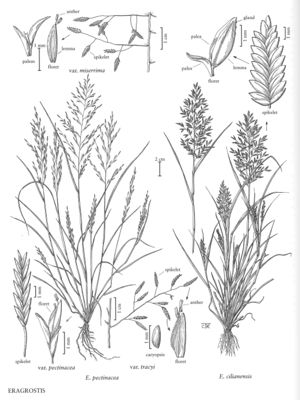Eragrostis cilianensis
Plants annual; tufted, without innovations. Culms 15-45 (65) cm, erect or decumbent, some¬times with crateriform glands below the nodes. Sheaths glabrous, occasionally glandular, apices hairy, hairs to 5 mm; ligules 0.4-0.8 mm, ciliate; blades (1) 5-20 cm long, (1) 3-5 (10) mm wide, flat to involute, abaxial surfaces glabrous, sometimes glandular, adaxial surfaces scabridulous, occasionally also hairy. Panicles (3) 5-16 (20) cm long, 2-8.5 cm wide, oblong to ovate, condensed to open; primary branches 0.4-5 cm, appressed or diverging 20-80° from the rachises; pulvini glabrous or hairy; pedicels 0.2-3 mm, stout, straight, stiff, usually divergent, occasionally appressed. Spikelets 6-20 mm long, 2-4 mm wide, ovatelanceolate, plumbeous, greenish, with 10-40 florets; disarticulation below the florets, each floret falling as a unit, rachillas persistent. Glumes broadly ovate to lanceolate, membranous, usually glandular; lower glumes 1.2-2 mm, usually 1-veined; upper glumes 1.2-2.6 mm, often 3-veined; lemmas 2-2.8 mm, broadly ovate, membranous, keels with 1-3 crateriform glands, apices obtuse to acute; paleas 1.2-2.1 mm, hyaline, keels scabrous, sometimes also ciliate, cilia to 0.3 mm, apices obtuse to acute; anthers 3, 0.2-0.5 mm, yellow. Caryopses 0.5-0.7 mm, globose to broadly ellipsoid, smooth to faintly striate, not grooved, reddish-brown or translucent. 2n = 20.
Distribution
Conn., N.J., N.Y., Wash., Mich., Del., D.C., Wis., W.Va., Pacific Islands (Hawaii), Mass., Maine, N.H., R.I., Vt., Fla., Wyo., N.Mex., Tex., La., Md., Tenn., N.C., S.C., Pa., Nev., Va., Colo., Alta., B.C., Man., N.S., Ont., Que., Sask., Calif., Ala., Kans., N.Dak., Nebr., Okla., S.Dak., Ark., Ill., Ga., Ind., Iowa, Ariz., Idaho, Mont., Oreg., Ohio, Utah, Mo., Minn., Miss., Ky.
Discussion
Eragrostis cilianensis is an introduced European species that now grows in disturbed sites such as pastures and roadsides, at 0-2300 m, through most of the contiguous United States and southern Canada. The English name refers to the odor of fresh plants.
Selected References
None.
Lower Taxa
"decumbent" is not a number.
